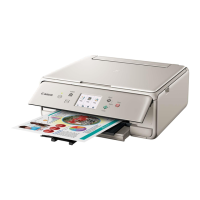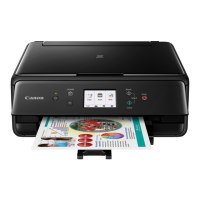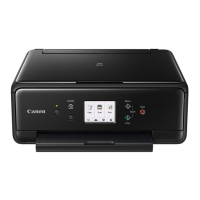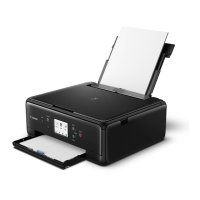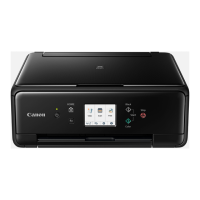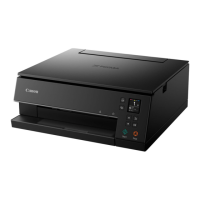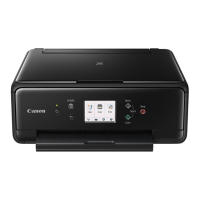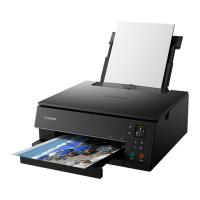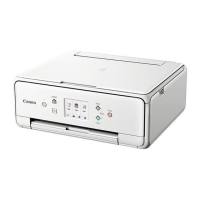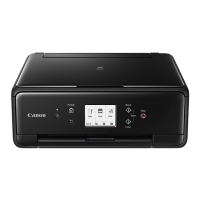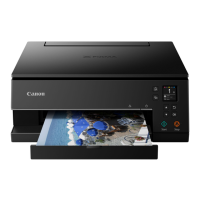Do you have a question about the Canon PIXMA TS6050 and is the answer not in the manual?
Explains symbols for warnings, notes, and instructions.
Guidance for operating the device via touch interfaces on Windows.
Explains how to print photos from a computer using the printer.
Details the process of making copies using the printer's functionality.
Instructions on how to load various types of paper into the printer.
Guidance on placing documents or photos for scanning or copying.
Step-by-step instructions for replacing ink tanks in the printer.
How to check the remaining ink levels directly on the printer's touch screen.
Using the printer's indicator lamps to determine the status of ink tanks.
Troubleshooting steps for issues like faint prints or uneven output quality.
Procedures for cleaning various parts of the printer to maintain performance.
Important safety precautions to prevent injury and damage during operation.
Identifies and explains the function of the printer's main parts and components.
How to modify printer settings from your computer or the operation panel.
Information and tips on connecting the printer to a network for shared use.
Tips and settings to achieve the best possible print quality and performance.
Detailed identification of the printer's physical components and their functions.
Information on how to connect and manage the printer's power supply.
Guide on how to navigate and use the printer's touch screen and buttons.
Steps to adjust printer settings via software on a Windows PC.
Steps to adjust printer settings via software on a Mac OS computer.
How to configure printer settings directly using the device's control panel.
Settings related to printer functions like device settings, language, and ECO options.
Settings related to paper handling and print configurations.
Settings for system management, firmware updates, and resets.
Adjusts printer settings to prevent paper abrasion during printing.
Controls the image extension for borderless printing to fill the entire page.
Adjusts the print position to correct misalignment of left/right margins.
Provides advice and solutions for common network connectivity issues.
Advice on ink usage, replacement, and maintenance for optimal print quality.
General recommendations for achieving better printing outcomes.
Verifying paper size and type settings before initiating a print job.
Registering loaded paper details to prevent misprints and ensure correct feeding.
Safety guidelines and best practices for handling the printer to prevent damage.
Methods and settings to maintain consistent and high-quality print output.
Technical details and dimensions of the printer's hardware and features.
Details regarding the performance and settings for the copying function.
Technical details of the scanning capabilities, including resolution and drivers.
Information on supported network protocols, security, and connection methods.
Required operating system, disk space, and display for software installation.
How to print documents using application software on Windows.
How to print documents using application software on Mac OS.
Instructions for printing using Canon's proprietary software applications.
Instructions for printing wirelessly from Mac devices using AirPrint.
Verifying the printer is powered on and in an operational state.
Instructions for correctly loading paper into the printer's paper source.
Guides users on selecting the correct printer model in the print dialog.
How to choose the correct paper size for the print job in the application.
How to specify the quantity of copies and the sequence of pages for printing.
Steps for printing documents or photos without margins, extending to the paper edge.
How to enlarge or reduce pages to fit the selected paper size during printing.
Printing multiple pages on a single sheet of paper for efficiency.
Instructions for automatic two-sided printing to save paper.
Guidance on configuring the printer for printing addresses on envelopes.
Procedures for printing custom designs or addresses on postcards.
Configures messages to prevent misprints when paper settings mismatch.
Adjusts copy settings like magnification, intensity, and paper type.
Using the ICA driver for scanning documents and photos on Mac OS.
Scanning wirelessly from Mac devices using AirPrint functionality.
Advice and best practices for optimizing the scanning process.
Overview of the IJ Scan Utility application for scanning tasks.
Step-by-step guide to launching the IJ Scan Utility application.
How to use the auto scan feature for automatic item type detection.
Overview of the different screens and dialogs within IJ Scan Utility.
Scan items automatically, detecting type and applying default settings.
Scan items as documents, with specific settings for text readability.
Scan items as photos, optimizing settings for image quality.
Scan items using user-defined favorite settings for personalized results.
Combine scanned halves of large items into a single image.
Configures default scan actions for IJ Scan Utility or My Image Garden on computer.
Sets default scan actions when using the printer's operation panel.
Configures product use, email size limits, text detection language, and save folders.
Specifies the type of item to be scanned, such as documents or magazines.
Selects the color scanning mode (e.g., color, black and white) for the scan.
Sets the scan resolution, affecting image detail and file size.
Automatically enhances document scans for better readability, sharpening text.
Guides on correctly placing documents or photos on the platen for scanning.
How to configure network settings for scanning over a network.
Steps to send scanned data directly to a computer from the printer's panel.
Customizes scan settings like size, resolution, and data format via the operation panel.
Troubleshooting steps for when the printer fails to move or operate.
Solutions for issues related to network setup and connectivity.
Explains common error codes and messages and how to resolve them.
Addresses general operational issues and provides troubleshooting guidance.
Covers common issues and solutions related to wireless LAN connections.
Troubleshooting for direct wireless connections between devices and the printer.
Steps to resolve issues when the printer cannot print or connect to the network.
Tips and procedures for modifying network settings like SSID and security.
Troubleshooting steps when the printer cannot be detected on the network.
Common issues and solutions related to establishing and maintaining network connections.
Covers less common network issues not categorized elsewhere.
Solutions for when the printer unexpectedly becomes unavailable for use.
Troubleshooting steps for failed communication over a wireless LAN connection.
Resolving issues when printing or scanning fails from a networked computer.
Steps to take when the printer fails to initiate a print job.
Troubleshooting for when ink is not being dispensed from the print head.
Diagnosing and fixing issues with print quality like streaks or misaligned lines.
Resolving problems related to paper feeding and "no paper" errors.
Verifying the printer is powered on and in an operational state.
Ensuring the physical or network connection between the printer and computer is secure.
Verifying that paper settings on the printer match the loaded paper.
Removing pending print jobs that might be causing interference or delays.
Checking ink levels and the status of ink lamps to diagnose ink issues.
Ensuring all protective materials are removed from ink tanks before installation.
Diagnosing and cleaning clogged print head nozzles for proper ink ejection.
Verifying that paper and media type settings align with the loaded paper.
Selecting the correct print quality setting for the paper and print job.
Troubleshooting steps for blurry prints.
Diagnosing and fixing issues with incorrect or faded colors in prints.
Addressing the appearance of white streaks in printouts, often related to ink or nozzles.
Verifying paper and print quality settings to resolve misaligned lines.
Steps to align the print head for accurate line placement and print results.
Troubleshooting steps for smudged prints caused by paper handling or printer issues.
Addressing scratches on the printed surface of the paper.
Instructions for flattening curled paper to prevent feeding issues and smudging.
Adjusts printer settings to prevent paper abrasion during printing.
Reduces print intensity to prevent wavy paper and ink absorption issues.
Resizes documents to fit within the recommended printable area to avoid ink stains.
Steps to clean the paper feed rollers to ensure proper paper feeding.
Performing bottom plate cleaning to remove internal dirt and prevent smudging.
Increases ink drying time to prevent smudges and scratches on the printed surface.
General troubleshooting for scanning issues on Mac OS.
Explains error messages encountered in IJ Scan Utility on Mac OS.
Lists and explains error messages specific to IJ Scan Utility Lite.
Error messages related to the scanner driver (ICA) on Mac OS.
Troubleshooting steps when the printer does not power on.
Resolving issues where the printer unexpectedly turns off.
Troubleshooting steps for problems related to USB connections.
Steps to take when the printer cannot communicate with the computer via USB.
Solutions for issues encountered during MP Drivers installation.
Troubleshooting steps when Easy-WebPrint EX fails to launch or display its menu.
General guidance on how to handle errors displayed by the printer or computer.
Explains how to interpret and respond to various messages shown on the touch screen or computer.
Lists support codes and corresponding error messages displayed on the printer and computer.
Instructions for removing jammed paper visible in output slots or rear tray.
Procedures for removing jammed paper that is not easily visible.
Initial steps to safely remove jammed paper by powering off and unplugging the printer.
Locating and removing paper jams that are under the print head holder.
Instructions for loading paper into the rear tray to resolve a "no paper" error.
Adjusting paper guides to match the loaded paper size and ensure proper feeding.
Registering paper details on the printer to match the loaded paper type.
Steps for loading paper into the cassette to clear a paper jam error.
Adjusting cassette paper guides to ensure correct paper alignment and feeding.
Registering paper details for the cassette to match the loaded paper.
Instructs to close the scanning unit/cover and wait, often to allow internal processes.
In case of print head damage, contact Canon service for professional repair.
Recommends replacing ink tanks when the ink lamp flashes, indicating low ink.
Instructions for installing an ink tank when it is not detected or installed correctly.
Replace the ink tank and close the cover; printing may damage the printer if ink is low.
Replace ink tank if printer detected ink out condition; disabling function prevents damage.
Continue printing by acknowledging the message, but contact service if ink absorber is full.
Check and remove transportation tape from the print head holder to ensure proper operation.
Explains printer driver settings and how they relate to cassette paper information.
Details the paper size and type information registered on the printer for the cassette.
Option to print/copy using the loaded paper without changing settings.
Option to replace paper in the cassette to match print settings and then proceed.
Ensure correct placement of the alignment sheet on the platen glass for accurate adjustment.
Keep the platen glass and alignment sheet clean to ensure proper scanning.
Verify that the correct type of paper is loaded for print head alignment.
Check print head nozzles for clogs, potentially by printing a nozzle check pattern.
Instructions for placing the print head alignment sheet on the platen glass.
Cancel printing and change settings if current settings prevent printing.
Steps to power off and unplug the printer to resolve a general error.
Power cycle the printer by turning it off, unplugging, and then turning it back on.
Ensure the print head holder's movement is not obstructed by tape or jammed paper.
Verify that ink tanks are correctly installed and clicked into place.
Power cycle the printer to resolve an error by turning off, unplugging, and turning back on.
If a printer error occurs, contact Canon service for professional repair assistance.
Remove jammed paper based on its location and cause, referring to support codes.
Check for and remove any obstructions preventing print head holder movement.
Ensure ink tanks are correctly installed, pressing until they click into place.
Explains symbols for warnings, notes, and instructions.
Guidance for operating the device via touch interfaces on Windows.
Explains how to print photos from a computer using the printer.
Details the process of making copies using the printer's functionality.
Instructions on how to load various types of paper into the printer.
Guidance on placing documents or photos for scanning or copying.
Step-by-step instructions for replacing ink tanks in the printer.
How to check the remaining ink levels directly on the printer's touch screen.
Using the printer's indicator lamps to determine the status of ink tanks.
Troubleshooting steps for issues like faint prints or uneven output quality.
Procedures for cleaning various parts of the printer to maintain performance.
Important safety precautions to prevent injury and damage during operation.
Identifies and explains the function of the printer's main parts and components.
How to modify printer settings from your computer or the operation panel.
Information and tips on connecting the printer to a network for shared use.
Tips and settings to achieve the best possible print quality and performance.
Detailed identification of the printer's physical components and their functions.
Information on how to connect and manage the printer's power supply.
Guide on how to navigate and use the printer's touch screen and buttons.
Steps to adjust printer settings via software on a Windows PC.
Steps to adjust printer settings via software on a Mac OS computer.
How to configure printer settings directly using the device's control panel.
Settings related to printer functions like device settings, language, and ECO options.
Settings related to paper handling and print configurations.
Settings for system management, firmware updates, and resets.
Adjusts printer settings to prevent paper abrasion during printing.
Controls the image extension for borderless printing to fill the entire page.
Adjusts the print position to correct misalignment of left/right margins.
Provides advice and solutions for common network connectivity issues.
Advice on ink usage, replacement, and maintenance for optimal print quality.
General recommendations for achieving better printing outcomes.
Verifying paper size and type settings before initiating a print job.
Registering loaded paper details to prevent misprints and ensure correct feeding.
Safety guidelines and best practices for handling the printer to prevent damage.
Methods and settings to maintain consistent and high-quality print output.
Technical details and dimensions of the printer's hardware and features.
Details regarding the performance and settings for the copying function.
Technical details of the scanning capabilities, including resolution and drivers.
Information on supported network protocols, security, and connection methods.
Required operating system, disk space, and display for software installation.
How to print documents using application software on Windows.
How to print documents using application software on Mac OS.
Instructions for printing using Canon's proprietary software applications.
Instructions for printing wirelessly from Mac devices using AirPrint.
Verifying the printer is powered on and in an operational state.
Instructions for correctly loading paper into the printer's paper source.
Guides users on selecting the correct printer model in the print dialog.
How to choose the correct paper size for the print job in the application.
How to specify the quantity of copies and the sequence of pages for printing.
Steps for printing documents or photos without margins, extending to the paper edge.
How to enlarge or reduce pages to fit the selected paper size during printing.
Printing multiple pages on a single sheet of paper for efficiency.
Instructions for automatic two-sided printing to save paper.
Guidance on configuring the printer for printing addresses on envelopes.
Procedures for printing custom designs or addresses on postcards.
Configures messages to prevent misprints when paper settings mismatch.
Adjusts copy settings like magnification, intensity, and paper type.
Using the ICA driver for scanning documents and photos on Mac OS.
Scanning wirelessly from Mac devices using AirPrint functionality.
Advice and best practices for optimizing the scanning process.
Overview of the IJ Scan Utility application for scanning tasks.
Step-by-step guide to launching the IJ Scan Utility application.
How to use the auto scan feature for automatic item type detection.
Overview of the different screens and dialogs within IJ Scan Utility.
Scan items automatically, detecting type and applying default settings.
Scan items as documents, with specific settings for text readability.
Scan items as photos, optimizing settings for image quality.
Scan items using user-defined favorite settings for personalized results.
Combine scanned halves of large items into a single image.
Configures default scan actions for IJ Scan Utility or My Image Garden on computer.
Sets default scan actions when using the printer's operation panel.
Configures product use, email size limits, text detection language, and save folders.
Specifies the type of item to be scanned, such as documents or magazines.
Selects the color scanning mode (e.g., color, black and white) for the scan.
Sets the scan resolution, affecting image detail and file size.
Automatically enhances document scans for better readability, sharpening text.
Guides on correctly placing documents or photos on the platen for scanning.
How to configure network settings for scanning over a network.
Steps to send scanned data directly to a computer from the printer's panel.
Customizes scan settings like size, resolution, and data format via the operation panel.
Troubleshooting steps for when the printer fails to move or operate.
Solutions for issues related to network setup and connectivity.
Explains common error codes and messages and how to resolve them.
Addresses general operational issues and provides troubleshooting guidance.
Covers common issues and solutions related to wireless LAN connections.
Troubleshooting for direct wireless connections between devices and the printer.
Steps to resolve issues when the printer cannot print or connect to the network.
Tips and procedures for modifying network settings like SSID and security.
Troubleshooting steps when the printer cannot be detected on the network.
Common issues and solutions related to establishing and maintaining network connections.
Covers less common network issues not categorized elsewhere.
Solutions for when the printer unexpectedly becomes unavailable for use.
Troubleshooting steps for failed communication over a wireless LAN connection.
Resolving issues when printing or scanning fails from a networked computer.
Steps to take when the printer fails to initiate a print job.
Troubleshooting for when ink is not being dispensed from the print head.
Diagnosing and fixing issues with print quality like streaks or misaligned lines.
Resolving problems related to paper feeding and "no paper" errors.
Verifying the printer is powered on and in an operational state.
Ensuring the physical or network connection between the printer and computer is secure.
Verifying that paper settings on the printer match the loaded paper.
Removing pending print jobs that might be causing interference or delays.
Checking ink levels and the status of ink lamps to diagnose ink issues.
Ensuring all protective materials are removed from ink tanks before installation.
Diagnosing and cleaning clogged print head nozzles for proper ink ejection.
Verifying that paper and media type settings align with the loaded paper.
Selecting the correct print quality setting for the paper and print job.
Troubleshooting steps for blurry prints.
Diagnosing and fixing issues with incorrect or faded colors in prints.
Addressing the appearance of white streaks in printouts, often related to ink or nozzles.
Verifying paper and print quality settings to resolve misaligned lines.
Steps to align the print head for accurate line placement and print results.
Troubleshooting steps for smudged prints caused by paper handling or printer issues.
Addressing scratches on the printed surface of the paper.
Instructions for flattening curled paper to prevent feeding issues and smudging.
Adjusts printer settings to prevent paper abrasion during printing.
Reduces print intensity to prevent wavy paper and ink absorption issues.
Resizes documents to fit within the recommended printable area to avoid ink stains.
Steps to clean the paper feed rollers to ensure proper paper feeding.
Performing bottom plate cleaning to remove internal dirt and prevent smudging.
Increases ink drying time to prevent smudges and scratches on the printed surface.
General troubleshooting for scanning issues on Mac OS.
Explains error messages encountered in IJ Scan Utility on Mac OS.
Lists and explains error messages specific to IJ Scan Utility Lite.
Error messages related to the scanner driver (ICA) on Mac OS.
Troubleshooting steps when the printer does not power on.
Resolving issues where the printer unexpectedly turns off.
Troubleshooting steps for problems related to USB connections.
Steps to take when the printer cannot communicate with the computer via USB.
Solutions for issues encountered during MP Drivers installation.
Troubleshooting steps when Easy-WebPrint EX fails to launch or display its menu.
General guidance on how to handle errors displayed by the printer or computer.
Explains how to interpret and respond to various messages shown on the touch screen or computer.
Lists support codes and corresponding error messages displayed on the printer and computer.
Instructions for removing jammed paper visible in output slots or rear tray.
Procedures for removing jammed paper that is not easily visible.
Initial steps to safely remove jammed paper by powering off and unplugging the printer.
Locating and removing paper jams that are under the print head holder.
Instructions for loading paper into the rear tray to resolve a "no paper" error.
Adjusting paper guides to match the loaded paper size and ensure proper feeding.
Registering paper details on the printer to match the loaded paper type.
Steps for loading paper into the cassette to clear a paper jam error.
Adjusting cassette paper guides to ensure correct paper alignment and feeding.
Registering paper details for the cassette to match the loaded paper.
Instructs to close the scanning unit/cover and wait, often to allow internal processes.
In case of print head damage, contact Canon service for professional repair.
Recommends replacing ink tanks when the ink lamp flashes, indicating low ink.
Instructions for installing an ink tank when it is not detected or installed correctly.
Replace the ink tank and close the cover; printing may damage the printer if ink is low.
Replace ink tank if printer detected ink out condition; disabling function prevents damage.
Continue printing by acknowledging the message, but contact service if ink absorber is full.
Check and remove transportation tape from the print head holder to ensure proper operation.
Explains printer driver settings and how they relate to cassette paper information.
Details the paper size and type information registered on the printer for the cassette.
Option to print/copy using the loaded paper without changing settings.
Option to replace paper in the cassette to match print settings and then proceed.
Ensure correct placement of the alignment sheet on the platen glass for accurate adjustment.
Keep the platen glass and alignment sheet clean to ensure proper scanning.
Verify that the correct type of paper is loaded for print head alignment.
Check print head nozzles for clogs, potentially by printing a nozzle check pattern.
Instructions for placing the print head alignment sheet on the platen glass.
Cancel printing and change settings if current settings prevent printing.
Steps to power off and unplug the printer to resolve a general error.
Power cycle the printer by turning it off, unplugging, and then turning it back on.
Ensure the print head holder's movement is not obstructed by tape or jammed paper.
Verify that ink tanks are correctly installed and clicked into place.
Power cycle the printer to resolve an error by turning off, unplugging, and turning back on.
If a printer error occurs, contact Canon service for professional repair assistance.
Remove jammed paper based on its location and cause, referring to support codes.
Check for and remove any obstructions preventing print head holder movement.
Ensure ink tanks are correctly installed, pressing until they click into place.
| Print technology | Inkjet |
|---|---|
| Maximum resolution | 4800 x 1200 DPI |
| Economical printing | Yes |
| Print speed (ISO/IEC 24734) mono | 15 ipm |
| Print speed (ISO/IEC 24734) color | 10 ipm |
| Print speed (black, normal quality, A4/US Letter) | - ppm |
| Scan to | Cloud |
| Scanner type | Flatbed scanner |
| Input color depth | 48 bit |
| Maximum scan area | 216 x 297 mm |
| Output color depth | 24 bit |
| Optical scanning resolution | 1200 x 2400 DPI |
| Digital sender | - |
| Printing colors | Black, Cyan, Magenta, Pigment black, Yellow |
| Maximum duty cycle | - pages per month |
| Number of print cartridges | 5 |
| Copier resize | 25 - 400 % |
| Maximum copy resolution | - DPI |
| Maximum number of copies | 99 copies |
| N-in-1 copy function (N=) | 2, 4 |
| Faxing | No |
| Display | LCD |
| Product color | Black |
| Display diagonal | 2.95 \ |
| Market positioning | Home & office |
| Wi-Fi standards | 802.11b, 802.11g, Wi-Fi 4 (802.11n) |
| Security algorithms | WEP, WPA, WPA-PSK, WPA2-PSK |
| Mobile printing technologies | Apple AirPrint, Google Cloud Print, Mopria Print Service |
| Standard interfaces | USB, Wireless LAN |
| USB 2.0 ports quantity | 1 |
| Sound pressure level (printing) | 47 dB |
| AC input voltage | 100 - 240 V |
| AC input frequency | 50 - 60 Hz |
| Power consumption (off) | 0.2 W |
| Power consumption (copying) | 13 W |
| Power consumption (standby) | 1.4 W |
| Power consumption (average operating) | - W |
| Minimum storage drive space | 1500 MB |
| Mac operating systems supported | Mac OS X 10.0 Cheetah, Mac OS X 10.1 Puma, Mac OS X 10.10 Yosemite, Mac OS X 10.11 El Capitan, Mac OS X 10.2 Jaguar, Mac OS X 10.3 Panther, Mac OS X 10.4 Tiger, Mac OS X 10.5 Leopard, Mac OS X 10.6 Snow Leopard, Mac OS X 10.7 Lion, Mac OS X 10.8 Mountain Lion, Mac OS X 10.9 Mavericks |
| Mobile operating systems supported | Android, Windows 10 Mobile, Windows RT, iOS |
| Windows operating systems supported | Windows 10 Education, Windows 10 Education x64, Windows 10 Enterprise, Windows 10 Enterprise x64, Windows 10 Home, Windows 10 Home x64, Windows 10 Pro, Windows 10 Pro x64, Windows 7 Enterprise, Windows 7 Enterprise x64, Windows 7 Home Basic, Windows 7 Home Basic x64, Windows 7 Home Premium, Windows 7 Home Premium x64, Windows 7 Professional, Windows 7 Professional x64, Windows 7 Starter, Windows 7 Starter x64, Windows 7 Ultimate, Windows 7 Ultimate x64, Windows 8, Windows 8 Enterprise, Windows 8 Enterprise x64, Windows 8 Pro, Windows 8 Pro x64, Windows 8 x64, Windows 8.1, Windows 8.1 Enterprise, Windows 8.1 Enterprise x64, Windows 8.1 Pro, Windows 8.1 Pro x64, Windows 8.1 x64, Windows RT, Windows Vista Business, Windows Vista Business x64, Windows Vista Enterprise, Windows Vista Enterprise x64, Windows Vista Home Basic, Windows Vista Home Basic x64, Windows Vista Home Premium, Windows Vista Home Premium x64, Windows Vista Ultimate, Windows Vista Ultimate x64, Windows XP Home, Windows XP Home x64, Windows XP Professional, Windows XP Professional x64 |
| Bundled software | MP Driver including Scanning Utility My Image Garden with Full HD Movie Print Quick Menu |
| Paper input type | Paper tray |
| Total input capacity | - sheets |
| Maximum input capacity | 100 sheets |
| Operating temperature (T-T) | 15 - 30 °C |
| Operating relative humidity (H-H) | 10 - 80 % |
| Envelopes sizes | 10, DL |
| Photo paper sizes | 10x15, 13x18, 20x25 cm |
| Paper tray media types | Envelopes, Glossy paper, Matte paper, Photo paper, Plain paper |
| Recommended media weight | 64 - 105, 300 g/m² |
| Non-ISO print media sizes | Legal |
| ISO A-series sizes (A0...A9) | A4, A5 |
| ISO B-series sizes (B0...B9) | B5 |
| Borderless printing media sizes | 10x15, 13x18, 20x25, A4, Letter |
| Maximum ISO A-series paper size | A4 |
| Downloadable software | Easy-WebPrint EX |
| Harmonized System (HS) code | 84433100 |
| Depth | 315 mm |
|---|---|
| Width | 372 mm |
| Height | 139 mm |
